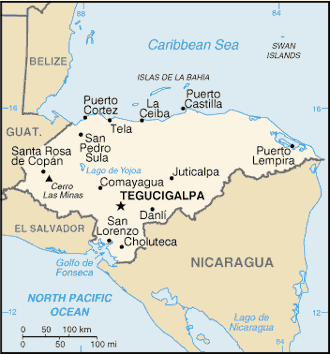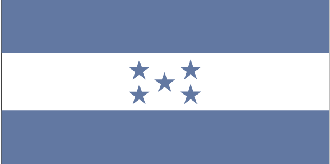
|
Honduras
Background:
Part of Spain's vast empire in the New World, Honduras became an independent
nation in 1821. After two and one-half decades of mostly military rule, a
freely elected civilian government came to power in 1982. During the 1980s,
Honduras proved a haven for anti-Sandinista contras fighting the Marxist
Nicaraguan Government and an ally to Salvadoran Government forces fighting
against leftist guerrillas. Hurricane Mitch devastated the country in 1998,
which killed about 5,600 people and caused almost $1 billion in damage.
Location:
Location: Middle America, bordering the Caribbean Sea, between Guatemala and
Nicaragua and bordering the Gulf of Fonseca (North Pacific Ocean), between El
Salvador and Nicaragua
Area: Total: 112,090 sq km.
Area - comparative: Slightly larger than Tennessee.
Land boundaries: Total: 1,520 km, border countries: Guatemala 256 km, El
Salvador 342 km, Nicaragua 922 km.
Coastline: 820 km.
Climate and Terrain:
Climate: Subtropical in lowlands, temperate in mountains.
Terrain: Mostly mountains in interior, narrow coastal plains.
Natural resources: Timber, gold, silver, copper, lead, zinc, iron ore,
antimony, coal, fish, hydropower.
People:
Population: 6,669,789.
Ethnic groups: mestizo (mixed Amerindian and European) 90%, Amerindian 7%,
black 2%, white 1%
Religions: Roman Catholic 97%, Protestant minority
Languages: Spanish, Amerindian dialects
Government:
Government type: Democratic constitutional republic.
Capital: Tegucigalpa.
Independence: 15 September 1821 (from Spain).
Economy overview:
Honduras, one of the poorest countries in the Western Hemisphere with an
extraordinarily unequal distribution of income, is banking on expanded trade
privileges under the Enhanced Caribbean Basin Initiative and on debt relief
under the Heavily Indebted Poor Countries (HIPC) initiative. While the country
has met most of its macroeconomic targets, it failed to meet the IMF's goals to
liberalize its energy and telecommunications sectors. Growth remains dependent
on the status of the US economy, its major trading partner, on commodity
prices, particularly coffee, and on reduction of the high crime rate.
Statistics:
Telephones - main lines in use: 234,000.
Telephones - mobile cellular: 14,427.
Radio broadcast stations: AM 241, FM 53, shortwave 12.
Radios: 2.45 million.
Television broadcast stations: 11 (plus 17 repeaters).
Televisions: 570,000.
Internet users: 40,000.
Railways: Total: 699 km.
Highways: Total: 13,603 km, paved: 2,775 km, unpaved: 10,828 km.
Airports - with paved runways: 12,
with unpaved runways: 103.
Return to Visiting Locations
|

